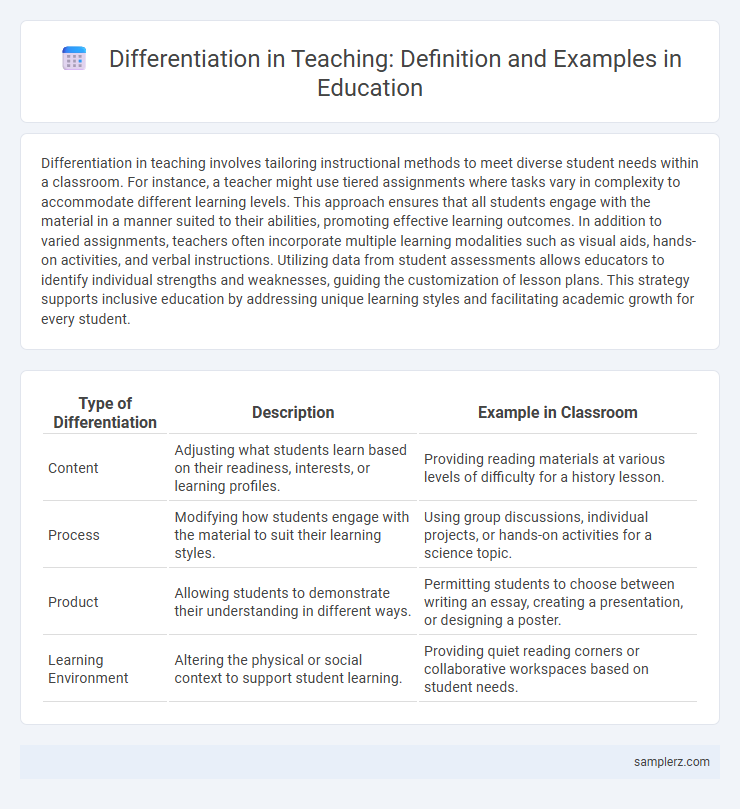Differentiation in teaching involves tailoring instructional methods to meet diverse student needs within a classroom. For instance, a teacher might use tiered assignments where tasks vary in complexity to accommodate different learning levels. This approach ensures that all students engage with the material in a manner suited to their abilities, promoting effective learning outcomes. In addition to varied assignments, teachers often incorporate multiple learning modalities such as visual aids, hands-on activities, and verbal instructions. Utilizing data from student assessments allows educators to identify individual strengths and weaknesses, guiding the customization of lesson plans. This strategy supports inclusive education by addressing unique learning styles and facilitating academic growth for every student.
Table of Comparison
| Type of Differentiation | Description | Example in Classroom |
|---|---|---|
| Content | Adjusting what students learn based on their readiness, interests, or learning profiles. | Providing reading materials at various levels of difficulty for a history lesson. |
| Process | Modifying how students engage with the material to suit their learning styles. | Using group discussions, individual projects, or hands-on activities for a science topic. |
| Product | Allowing students to demonstrate their understanding in different ways. | Permitting students to choose between writing an essay, creating a presentation, or designing a poster. |
| Learning Environment | Altering the physical or social context to support student learning. | Providing quiet reading corners or collaborative workspaces based on student needs. |
Understanding Differentiation in Teaching
Understanding differentiation in teaching involves tailoring instruction to meet diverse student needs by varying content, process, and product. Teachers use strategies like flexible grouping, tiered assignments, and individualized learning plans to enhance student engagement and mastery. This approach promotes equity by addressing different readiness levels, learning styles, and interests within the classroom.
Differentiation by Content: What Students Learn
Differentiation by content involves tailoring the material students learn based on their readiness levels, interests, and learning profiles, such as providing advanced texts for gifted learners and simplified resources for those needing support. Teachers might use varied reading materials, such as articles, videos, and interactive modules, to address diverse learning preferences while ensuring core concepts are covered. This approach enhances student engagement and comprehension by aligning instruction with individual student needs and cognitive abilities.
Differentiation by Process: How Students Learn
Differentiation by process in teaching involves tailoring instructional methods to match diverse learning styles, such as using visual aids for spatial learners or hands-on activities for kinesthetic learners. Teachers implement flexible grouping and varying question levels to engage students at their cognitive readiness and promote individual growth. This approach enhances student understanding by addressing how each learner processes information differently within the classroom environment.
Differentiation by Product: Showcasing Learning
Differentiation by product in teaching allows students to demonstrate their understanding through various outputs such as presentations, essays, or creative projects tailored to their strengths. This approach caters to diverse learning styles and encourages deeper engagement by offering choices that highlight individual skills and interests. Teachers can assess mastery more effectively by evaluating these varied products, providing a comprehensive picture of student learning.
Flexible Grouping Strategies in the Classroom
Flexible grouping strategies in the classroom enhance differentiated instruction by allowing teachers to organize students based on learning needs, interests, or skill levels. This approach fosters collaboration and personalized learning through dynamic group assignments that can change frequently according to specific lesson goals. Research shows that flexible grouping improves student engagement and achievement by addressing diverse learning preferences within a supportive environment.
Tiered Assignments for Diverse Learners
Tiered assignments in education offer varied levels of complexity, allowing diverse learners to engage with content at their appropriate readiness levels. This approach supports differentiated instruction by tailoring tasks that challenge advanced students while providing scaffolds for those needing additional support. Effective tiered assignments address learning styles, cognitive abilities, and interests, promoting inclusivity and maximizing student growth.
Using Technology for Differentiated Instruction
Using technology for differentiated instruction enables educators to tailor learning experiences to individual student needs by incorporating adaptive software, interactive digital resources, and multimedia presentations. Tools such as learning management systems, educational apps, and online assessments allow real-time feedback and personalized content pacing, supporting diverse learning styles and abilities. This approach enhances student engagement and promotes mastery by providing varied pathways to understand complex concepts effectively.
Scaffolded Support for Varied Readiness Levels
Scaffolded support in teaching involves tailoring instruction to students' varied readiness levels by breaking tasks into manageable steps and providing targeted assistance. For example, a teacher might offer graphic organizers to help struggling readers organize information while encouraging advanced students to analyze texts independently. This approach ensures that all learners engage meaningfully with the material, promoting comprehension and skill development across diverse abilities.
Differentiation for Students with Special Needs
Differentiation for students with special needs involves tailoring instruction to accommodate diverse learning abilities, such as providing modified materials, individualized learning plans, and assistive technology. Strategies like using multi-sensory approaches, flexible pacing, and targeted scaffolding help meet specific cognitive, physical, or emotional challenges. This personalized support enhances engagement and promotes equitable access to the curriculum for all learners.
Practical Examples of Differentiation in Action
Teachers implement tiered assignments by providing varying levels of task complexity based on students' readiness, ensuring that all learners engage with content at an appropriate challenge level. In small group instruction, educators tailor lessons to address specific learning styles and needs, such as using visual aids for visual learners or hands-on activities for kinesthetic learners. Flexible grouping allows students to collaborate in changing groups according to skill set or interest, promoting peer support and targeted instruction.

example of differentiation in teaching Infographic
 samplerz.com
samplerz.com